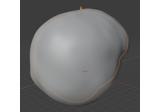mne.read_bem_surfaces#
- mne.read_bem_surfaces(fname, patch_stats=False, s_id=None, on_defects='raise', verbose=None)[source]#
Read the BEM surfaces from a FIF file.
- Parameters:
- fnamepath-like
The name of the file containing the surfaces.
- patch_statsbool, optional (default
False) Calculate and add cortical patch statistics to the surfaces.
- s_id
int|None If int, only read and return the surface with the given
s_id. An error will be raised if it doesn’t exist. If None, all surfaces are read and returned.- on_defects‘raise’ | ‘warn’ | ‘ignore’
What to do if the surface is found to have topological defects. Can be
'raise'(default) to raise an error,'warn'to emit a warning, or'ignore'to ignore when one or more defects are found. Note that a lot of computations in MNE-Python assume the surfaces to be topologically correct, topological defects may still make other computations (e.g.,mne.make_bem_modelandmne.make_bem_solution) fail irrespective of this parameter.New in v0.23.
- verbosebool |
str|int|None Control verbosity of the logging output. If
None, use the default verbosity level. See the logging documentation andmne.verbose()for details. Should only be passed as a keyword argument.
- Returns:
See also
